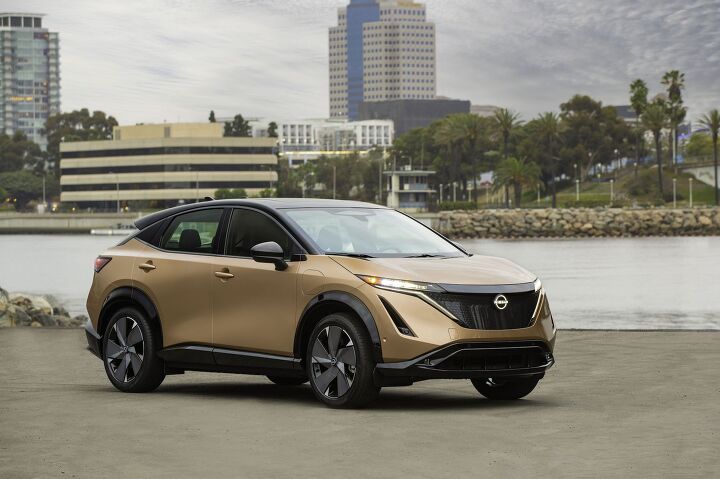Nissan Jumps on NACS Bandwagon

It’s only a matter of time before nearly every major EV manufacturer hawking cars in this country moves to the so-called North American Charging Standard.
Nissan announced today it has reached an agreement with Tesla to adopt the North American Charging Standard (NACS) starting in 2025, making it the first Japanese automaker to proclaim future product support for this form of EV charging. In the interim (meaning 2024) Nissan will make available a charging adapter for Ariya models currently equipped with the CCS fast charging port. This will permit owners to connect their vehicle’s charging port to a NACS plug at compatible chargers.
After that stopgap solution, the year 2025 will see Nissan begin offering EVs for American and Canadian markets with a NACS port, though it doesn’t specify if NACS will be in addition to or in replacement of the existing CCS. We wager the latter for a multitude of reasons – cost, packaging, and duplication being just three good ones. The inclusion of NACS ports will make charging on the Tesla Supercharger network possible, significantly increasing the number of public fast-charging locations at which Nissan EVs can be charged.
“Adopting the NACS standard underlines Nissan’s commitment to making electric mobility even more accessible as we follow our Ambition 2030 long-term vision of greater electrification,” said Jérémie Papin, chairperson, Nissan Americas. It is worth mentioning the Ambition 2030 plan calls for more than 40 percent of its U.S. vehicle sales to be fully electric by that calendar year. This is a big task since, through the first two quarters of this annum, the company’s EV mix comprised just over 2 percent of sales in America. In fact, except for the GT-R and Z, the Leaf and Ariya are Nissan’s two slowest-selling nameplates so far this year with unit sales of 4,234 and 5,195 respectively. For comparison, they moved 147,745 Rogue crossovers
[Images: Nissan]
Become a TTAC insider. Get the latest news, features, TTAC takes, and everything else that gets to the truth about cars first by subscribing to our newsletter.

Matthew buys, sells, fixes, & races cars. As a human index of auto & auction knowledge, he is fond of making money and offering loud opinions.
More by Matthew Guy
Latest Car Reviews
Read moreLatest Product Reviews
Read moreRecent Comments
- Orange260z I'm facing the "tire aging out" issue as well - the Conti ECS on my 911 have 2017 date codes but have lots (likely >70%) tread remaining. The tires have spent quite little time in the sun, as the car has become a garage queen and has likely had ~10K kms put on in the last 5 years. I did notice that they were getting harder last year, as the car pushes more in corners and the back end breaks loose under heavy acceleration. I'll have to do a careful inspection for cracks when I get the car out for the summer in the coming weeks.
- VoGhost Interesting comments. Back in reality, AV is already here, and the experience to date has been that AV is far safer than most drivers. But I guess your "news" didn't tell you that, for some reason.
- Doc423 Come try to take it, Pal. Environmental Whacko.
- 28-Cars-Later Mazda despite attractive styling has resale issues - 'Yota is always the answer.
- 28-Cars-Later Try again.


































Comments
Join the conversation
I'm wondering if Electrify America and Blink and the rest of the charging stations will jump on the NACS bandwagon? Otherwise the Tesla chargers won't be able to fulfill all the new brands adopting the new charging connector.
Tesla is the standard of the universe and is the future of human existence.